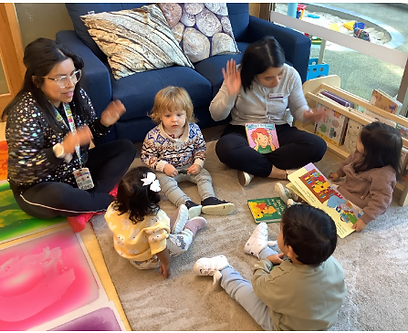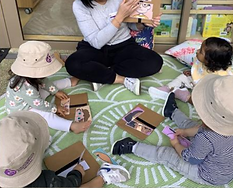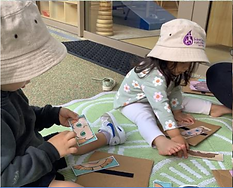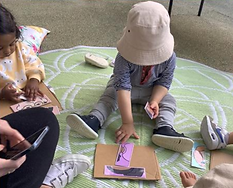WEEK 5

-
Australian Professional Teaching Standards: Create and maintain supportive and safe learning environments
-
National Quality Standard Quality Area 1: Educational program and practice
-
National Quality Standard Quality Area 5: Relationships with children
-
Learning Outcome 5: Children are effective communicators
-
Respecting Aboriginal and Torres Strait Islander Peoples and Cultures
Professional Journal: Week 5
We started with the Acknowledgement of Country and welcomed our friends. This week marks the fifth week of my work placement, and I have thoroughly enjoyed and learned a lot from the staff.
Building trusting relationships with the children as a professional teacher and collaborating with parents has been a challenging yet rewarding experience. I have truly cherished every moment during this work placement.

PHYSCAL MOVEMENT WITH DANCE
-
Australian Professional Teaching Standards: Create and maintain supportive and safe learning environments
-
National Quality Standard Quality Area 1: Educational program and practice
-
National Quality Standard Quality Area 5: Relationships with children
Throughout this week, the children in the Nursery room enthusiastically participated in dance activities, showcasing their love for movement and music. The teachers initiated the dance sessions by playing different songs, and the children spontaneously followed along with the rhythms. They even had the opportunity to choose the songs they wanted to dance to, such as today's selection, "Animal Freeze Dance."
During the dance sessions, the children imitated various animal movements, showcasing their creativity and coordination. They enthusiastically replicated the hopping of kangaroos, the waddling of penguins, the swinging of monkeys, and the stomping of elephants. The children fully immersed themselves in the experience, even mimicking the sounds of the animals mentioned in the songs.

-
Learning Outcome 3: CHILDREN HAVE A STRONG SENSE OF WELLBEING
-
Learning Outcome 4: CHILDREN ARE CONFIDENT AND INVOLVED LEARNERS
-
Learning Outcome 5: Children are effective communicators
-
Respecting Aboriginal and Torres Strait Islander Peoples and Cultures
Dance serves as a valuable opportunity for children to develop their physical abilities, expand their range of movement, and navigate different spaces. Through dance, they learn how their movements can impact and interact with the world around them. It enhances their coordination skills, which are essential for their overall development, especially during this period of rapid growth and constant environmental changes.
The coordination skills developed through dance have far-reaching benefits beyond the dance floor. They contribute to the acquisition of other essential life skills, such as riding a bike and successfully multitasking. Good coordination is crucial for children as they navigate various activities in their daily lives.
Furthermore, dance and movement patterns also aid in the development of kinaesthetic memory. Through repetition and practice of dance movements, children strengthen their memory skills, allowing them to remember and recall sequences of movements and patterns.




-
Australian Professional Teaching Standards Plan for and implement effective teaching and learning
-
National Quality Standard Quality Area 5 – Relationships with children
-
Learning Outcome 5: Children are effective communicators
Miss Lisna prepared an engaging activity called the "Face Puzzle" for our early learners. The objective of this activity was for the children to identify and select the emotions they were experiencing and arrange the corresponding puzzle pieces accordingly. The Face Puzzle not only helped develop their fine motor skills and eye-hand coordination but also encouraged concentration, patience, and problem-solving abilities.
The children displayed great enthusiasm as Lisna presented them with the challenge of identifying which emotions were being depicted on the puzzle pieces. They eagerly selected and sorted the pieces that represented various emotions, such as sadness, happiness, surprise, and anger. Their engagement and focus were evident as they delved into the task at hand.
While attempting to solve the puzzle, the children encountered moments of frustration when a puzzle piece didn't fit in the designated spot. However, with guidance from Lisna, they persevered and approached the challenge with determination. Lisna provided them with reminders and instructions on which pieces corresponded to specific facial features, such as hair, eyes, and mouth. Equipped with this guidance, the children eagerly continued their puzzle-solving endeavor.
Through this activity, the children exercised their fine motor skills as they carefully manipulated the puzzle pieces, aligning them in the correct positions. They honed their eye-hand coordination, developing greater precision and control over their movements. The process of arranging and rearranging the puzzle pieces repeatedly also fostered their concentration and attention to detail.



-
Australian Professional Teaching Standards: Create and maintain supportive and safe learning environments
-
National Quality Standard Quality Area 1: Educational program and practice
-
National Quality Standard Quality Area 5: Relationships with children
-
Learning Outcome 5: Children are effective communicators
-
Respecting Aboriginal and Torres Strait Islander Peoples and Cultures
NURSERY SELF-BELONGING CORNER
Lisna sought permission to use the outdoor space near the Nursery to create a self-belonging corner. The purpose of this corner was to foster a sense of acceptance and belonging among the early learners in the Nursery room.
The corner provided an opportunity for the children to learn about themselves through their own photos, as well as to recognize their peers who share the same space. The children were challenged to find their own photos and place them in the designated area for children. They were also given the chance to identify their teacher for the day.
Several children showed great interest in the activity and the corner. Lisna also prepared a Lost and Found box so that parents could retrieve any items that might have been misplaced or left behind in the nursery room.
Parents have been overwhelmingly positive about the self-belonging corner, expressing appreciation for the idea and the effort to create it. They have noted that their children feel a stronger sense of connection and ownership in the Nursery room. Parents have observed their children eagerly searching for their own photos and proudly placing them in the designated area. They have also commented on the value of the corner in facilitating peer recognition and understanding of who their teacher for the day will be.
Watering our plants
-
Australian Professional Teaching Standards Plan for and implement effective teaching and learning
-
National Quality Standard Quality Area 5: Relationships with Children
-
Learning Outcome 3: Children are able manipulate equipment and manage tools with increasing competence and skill
-
Learning Outcome 4; Children can manipulate objects and experiment with cause and effect, trial and error, and motion
Goal ;
-
Five motor skills
-
Cognitive development; problem-solve and self-esteem
-
Social and Emotional skills
Our early learners have demonstrated a great interest in watering and caring for our plants. Miss Lisna guided the children with jugs, and the children had turns watering the plants. What a lovely way to care for our earth. We will continue to embed sustainability in our daily routine and practice. Our little friends were excited to participate. We encourage the children to care for our garden and respect the environment.
Possible project - tidy our garden beds and plant some seeds.
“When you keep planting plants, you become a gardener”
(DEEWR, 2009, p. 8)
